
FourmiFood
Salmon Pasta Tonnato
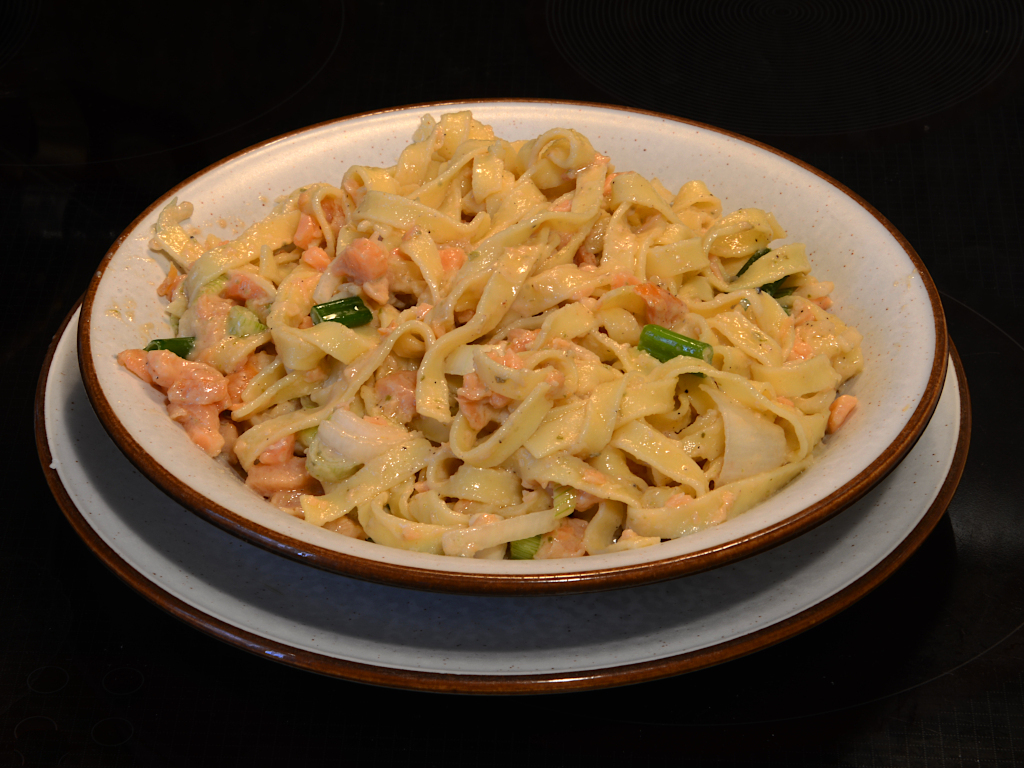

|
FourmiFoodSalmon Pasta Tonnato |

|
Vitello tonnato is a dish associated with the Piedmont region of northwest Italy, bordering Switzerland, and popular in regions where Piedmontese have settled, including Argentina, where it is considered a traditional Christmas dish. When you first hear of it, you may think it distinctly odd. Thinly sliced veal, served cold with a sauce made of, inter alia, tuna fish, anchovies, capers, lemon juice, garlic, and mayonnaise, doesn't immediately strike one as toothsome, but most who try it conclude that it works, the different flavours in the sauce complementing one another and producing a unique taste that enhances the otherwise somewhat bland veal.
For years, I had been making, as one of my regular meals, a simple yet hearty and tasty dish consisting of fettucini or tagliatelle pasta (like spaghetti, but long flat noodles rather than round) tossed with cubed smoked salmon, chopped green onions (scallions), lemon juice, butter, creamed horseradish, and a store-bought topping which varied from creamed salmon (rarely available), lemon-butter (🌐beurre citronné), or a simple mushroom sauce.
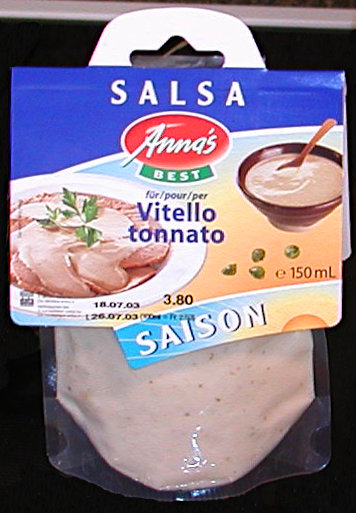 One day in the early 2000s, I was in the store looking for sauce to
make this dinner and happened upon a “seasonal special”: ready-to-use
vitello tonnato sauce. Having previously enjoyed the veal dish, sold
ready-to-eat, on summer days, I decided, on a lark, to give it a try.
It was magnificent! The mix of flavours was much better than
anything I'd tried before, and I decided this was the way go.
One day in the early 2000s, I was in the store looking for sauce to
make this dinner and happened upon a “seasonal special”: ready-to-use
vitello tonnato sauce. Having previously enjoyed the veal dish, sold
ready-to-eat, on summer days, I decided, on a lark, to give it a try.
It was magnificent! The mix of flavours was much better than
anything I'd tried before, and I decided this was the way go.
Then, of course, as seems to be the case whenever I discover something
in the supermarket that I really like, it disappeared at the end of the
“season”, never to be seen again. It became clear that if I wanted to
enjoy this chance discovery once again, I'd have to make my own sauce
from scratch, as we're about to do here. It's not much of a bother,
doesn't take long, and won't require a lot of cleaning up afterward.
Plus, you can make the sauce in advance, refrigerate it, and have it
ready to go whenever you decide to throw together the pasta dish.
The sauce recipe here is bog-standard vitello tonnato sauce (although you'll see variations in different recipes) and can be used in many recipes other than this pasta dish. Heck, you can even put it on thinly sliced veal! I find it is a particularly delicious sauce for crudités (bite-sized assorted raw vegetables), and it should be excellent as one of the dips served with fondue chinoise (hot pot with thinly sliced meat).
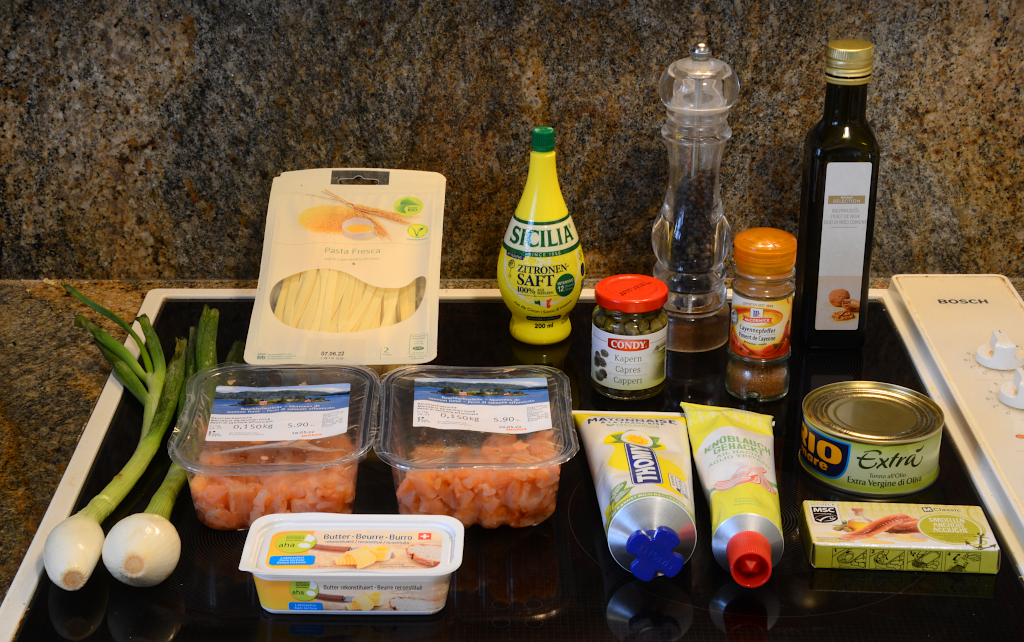
Let's go to the kitchen and get started. Above are the ingredients for the complete dish. The quantities given make around two servings, depending upon how hungry you are and what you're having with it. Because you may want to use the sauce in other recipes, I'll list the ingredients and provide instructions separately for the sauce and pasta.
You can make the tonnato sauce earlier, like the day before, and store it in the frigo until you're ready to prepare and serve the main dish. This cuts the final preparation to just boiling the pasta and cutting up the green onions and salmon (if not already cubed). I use “tbsp” (tablespoon) to denote a volume of 15 millilitres and “tsp” (teaspoon) for a third that (5 millilitres). It's cooking, not chemistry—don't obsess on exact quantities!
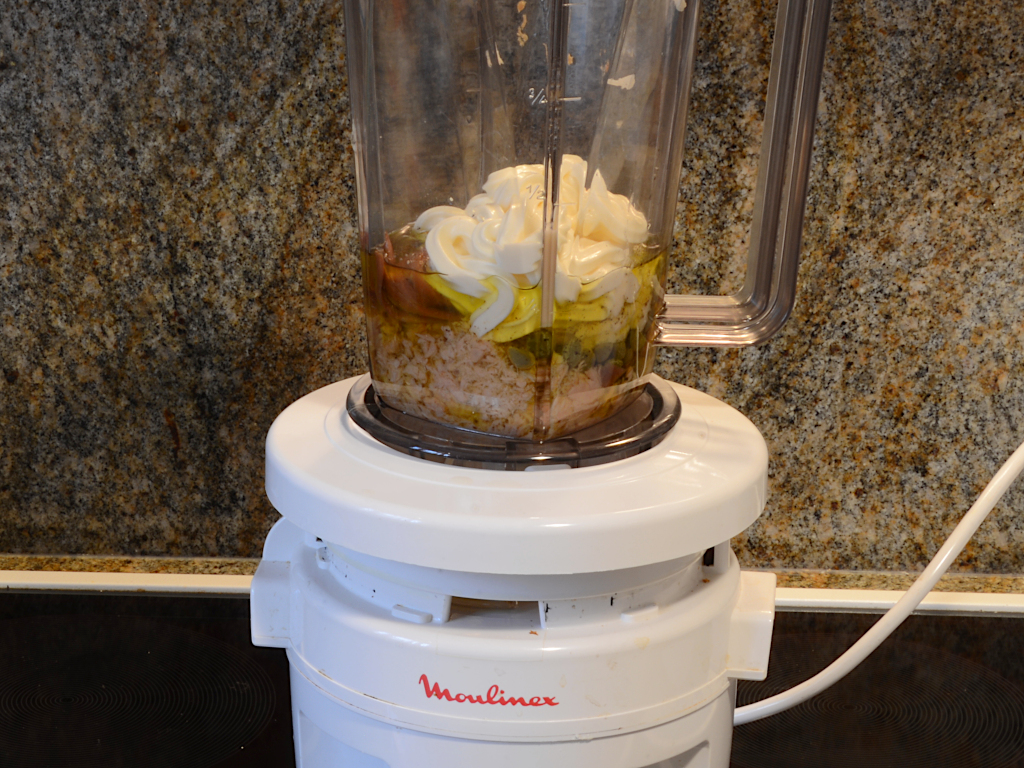 Dump all of the sauce ingredients in a blender. If you don't have a
blender or equivalent, I don't recommend making this sauce as it's
difficult to blend to the desired smooth consistency by hand. Flake the
tuna fish from the can into the blender, then pour in the remaining oil
and chase the last fragments of tuna into the blender with a spoon. If
your anchovy fillets come, as mine do, in a small tin with about 6
fillets (15 grams drained), add the whole thing including the oil in
which they're packed. If you have a large package, add six fillets.
Dump all of the sauce ingredients in a blender. If you don't have a
blender or equivalent, I don't recommend making this sauce as it's
difficult to blend to the desired smooth consistency by hand. Flake the
tuna fish from the can into the blender, then pour in the remaining oil
and chase the last fragments of tuna into the blender with a spoon. If
your anchovy fillets come, as mine do, in a small tin with about 6
fillets (15 grams drained), add the whole thing including the oil in
which they're packed. If you have a large package, add six fillets.
Add the capers, lemon juice, garlic, cayenne pepper, black pepper, and
olive oil. If your tuna and anchovies were not packed in oil, you'll
probably want to drain them and double the amount of olive oil added.
Finally, add the mayonnaise. It may seem like a lot, but like so many
sauces, it's mostly mayonnaise.
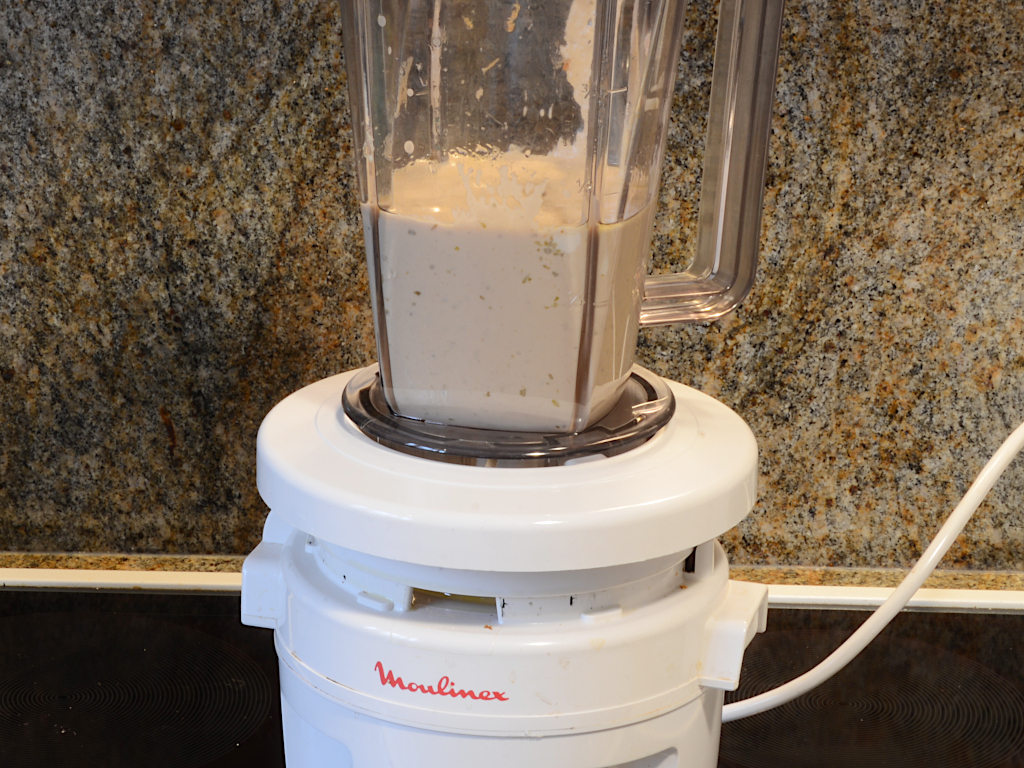 Now blend everything together until it's entirely uniform with no
lumps. If you have one one of those blenders with twenty-five or so
amusingly labeled buttons for various speeds, choose one of the
fastest. I use the blender attachment for a food processor with only
one speed, very fast, and it takes around a dozen pulses of about a
second with time between pulses to let the mix settle to blend it to
perfection.
Now blend everything together until it's entirely uniform with no
lumps. If you have one one of those blenders with twenty-five or so
amusingly labeled buttons for various speeds, choose one of the
fastest. I use the blender attachment for a food processor with only
one speed, very fast, and it takes around a dozen pulses of about a
second with time between pulses to let the mix settle to blend it to
perfection.
If you're preparing the sauce for use later, pour it into an airtight
refrigerator container (a rubber spatula will help getting the last
bits out of the blender) and refrigerate until you're ready to use.
The next day is fine (and may allow the flavours to blend better), but
I wouldn't go much longer than a few days before using it.
 With the sauce prepared, fill a pot with enough water to entirely
submerge the pasta, add a couple of teaspoons of salt, and bring it to
a boil. While you're waiting for the water to boil, cut up the green
onions into pieces around 1 centimetre long. Green onions vary greatly
in size. Use as many as it takes so you have about an equal volume of
green onions and chopped salmon. If the smoked salmon you've bought is
not already chopped into pieces, do so now, aiming for bite size 1
centimetre pieces. (At least in Switzerland, smoked salmon sold in
pieces is much less expensive than large slabs since the bits can be
cut from the dribs and drabs left over from the big chunks preferred
by plutocrats.)
With the sauce prepared, fill a pot with enough water to entirely
submerge the pasta, add a couple of teaspoons of salt, and bring it to
a boil. While you're waiting for the water to boil, cut up the green
onions into pieces around 1 centimetre long. Green onions vary greatly
in size. Use as many as it takes so you have about an equal volume of
green onions and chopped salmon. If the smoked salmon you've bought is
not already chopped into pieces, do so now, aiming for bite size 1
centimetre pieces. (At least in Switzerland, smoked salmon sold in
pieces is much less expensive than large slabs since the bits can be
cut from the dribs and drabs left over from the big chunks preferred
by plutocrats.)
Once the water is boiling, add the pasta and, if it's the dry sort,
persuade it to submerge entirely with a spatula, then start the timer.
Fresh pasta usually cooks in around two minutes and dry in about
six—use the time recommended on the package. As soon as the
water resumes boiling after you add the pasta, reduce heat until
it's just boiling—additional heat doesn't make the pasta cook
any quicker, wastes energy, steams up your kitchen, and may
cause the pasta to foam and boil over, making a mess.
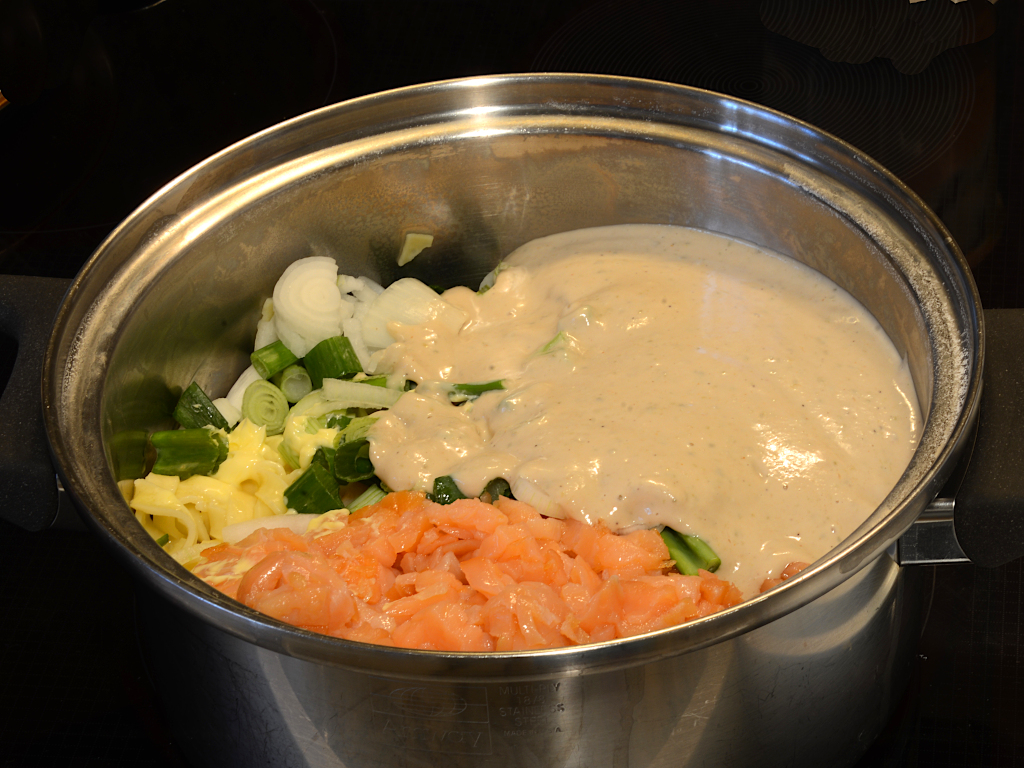
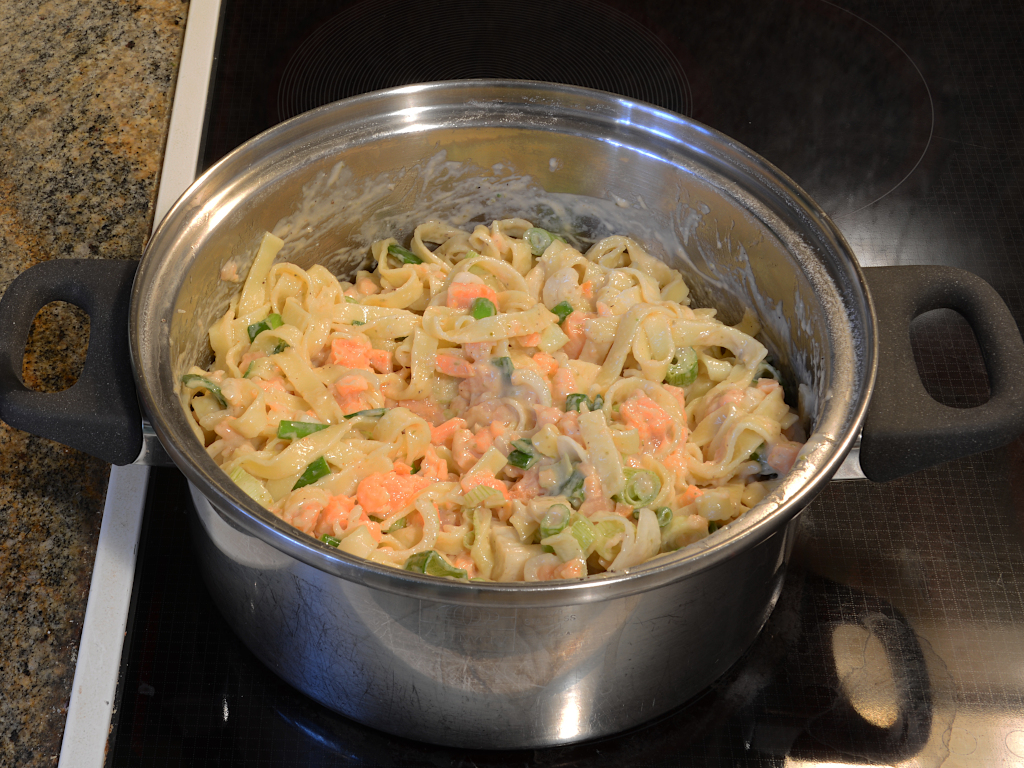
When the timer beeps, drain the pasta into a colander. Don't rinse, but stir with a spatula to allow trapped water to drain. Now dump the drained pasta back into the now-empty pot in which it was just boiled, add the butter, chopped salmon and green onions, then pour the tonnato sauce over the top, using a spoon or spatula to chase the last bits of sauce out of the blender. Using a spatula or spoon, toss and stir until everything is well mixed. If you're using previously prepared tonnato sauce just removed from the refrigerator, put the pot on a burner at medium-low heat to warm things up for serving, stirring as it warms up.

And now, just ladle servings into bowls and encourage diners to season with pepper and salt to taste. The anchovies are very salty, so you may not need any additional salt.
Bon appetit!
If you have leftovers, pack into refrigerator boxes (I prefer serving-sized boxes that can be used individually when desired) and keep in the frigo. It's fine warmed in the microwave or, as a snack, cold.
Since the main dish is made entirely in one pot, there's little cleaning up to do. The biggest chore is abstergifying the blender, as the tonnato sauce is somewhat clingy and if your blender container cannot be disassembled for cleaning, it may not be easy to remove all of it around the blades at the bottom. I find the easiest way is, immediately after pouring the sauce from the blender, to rinse the inside several times with a strong stream of hot running water, then fill with hot water about half way and allow to stand. When you're ready to clean up, pour out the water, rinse again, then re-fill about 1/3 with hot water and a little liquid dish detergent. Put the container on the blender, secure the cover (don't forget, unless you want to make a mess), and blend for a few seconds on high speed. That should dislodge the last bits, leaving the dishwasher to do the rest.
The pasta, salmon, and onion dish works well with a variety of other sauces including, as I noted, lemon-butter and mushroom. I find that when using blander sauces like these, adding lemon juice and creamed horseradish to the mix will contribute interesting tastes.
I usually eat this dish hot, immediately after preparation, but it's also fine as a cold salad for picnics, buffets, or pot-luck dinners. You can make the pasta dish, refrigerate, then add the sauce and toss immediately before serving. When people admire it and ask, “What the heck is that?”, you may find that answering, “Salmon and pasta with tuna fish and anchovy sauce”, may result in weird looks and folks moving away from you on the Group W bench. Just say, “Antie's recipe—I'd have to kill you if I told you” and enjoy watching them go for seconds.